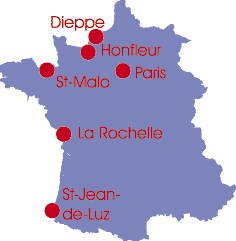Historical Context
At the Dawn of the "Age of Reason"!
(1600)
The first quarter of the
seventeenth century was a difficult time for France. The country fluctuated
between order and chaos, according to the regent or monarch in power. The
disruption of the social order, combined with intellectual stirrings,
heralded a century of change.
 | France,
circa 1600 |
From 1524, following the dispatch of explorers by the King of France,
a number of cartographers took to referring to the vast northern expanses of
North America as "New France." The territory situated to the south and west
of Newfoundland, linked to the continent, was called "Acadia," and the land
along the banks of Canada’s vast river, the St. Lawrence, was known by its
Indian name, Canada.
Map by G. Levasseur, 1601
Synthesis of what was known of
the Gulf of St. Lawrence and
the St. Lawrence Valley before Champlain’s
arrival
Bibliothèque nationale, Paris, France
In France
Religious differences continued to divide the people. While the
Protestants from Brittany and Normandy declared their loyalty to the "Most
Catholic" King of France, Protestants in the west and south rebelled again.
|
Henri IV, the son of a Calvinist mother and a Catholic father, was
assassinated on May 14, 1610, leaving his wife, Marie de Médicis, as
regent until his eldest son, Louis XIII (then nine years old), reached the
age of majority. In 1624, the young man was made king. Cardinal Richelieu,
who later founded the Company of One Hundred Associates, helped Louis XIII
rule.
|
Henri IV,
circa 1610
Engraving
Nicolo Van Aelst (1527-1612)
Musée Carnavalet, Paris, France
|
|
Cardinal Richelieu,
1635
by Philippe de Champaigne
La Sorbonne, Paris, France
|
|
Under the new monarch, civil calm was restored and opportunists began
to solicit the sovereign’s support. Ever since Jacques Cartier had mistaken
sulphur ore for gold and quartz for diamonds, there had been little interest
in sending French citizens overseas permanently, leaving whalers, cod
fishermen and fur traders to finance their own seasonal expeditions.
|
|
|
Saint-Malo, view from
Paramé, 17th century
Anonymous engraving
Musée de Saint-Malo
|
Now, merchants from France’s major ports, almost maritime republics,
demanded the right to trade freely with the Indians and fought for the
monopolies within the fur trade. Their interventions and protests to the
court delayed the process of setting up French outposts in the interior of
the North American continent.
From Dieppe to Canada
In 1603, at the invitation of Commander de Chaste, the Governor of
Dieppe, Champlain made his first voyage to Canada.
View of Dieppe, 1650
Engraving
Private collection
With the king’s approval, a company made up of several gentlemen and
the leading merchants of Rouen fitted out three ships at Saint-Malo, for
departure from Honfleur.
Decree from the King’s
Council authorizing captains Colombier, Prévert and Pont-Gravé
to fit out three ships at Saint-Malo, 1603
Photo: Archives nationales de
France
E5A, fol. 248
| |
Paris, March 13, 1603
Regarding the petition submitted by the
burgesses and inhabitants of St-Malo, that it please the king to make free,
this year and in the future, the trade that was discovered in Canada at
great expense by their predecessors. Notwithstanding the authorizations and
prohibitions claimed by captains Prevert and Pont-Gravé. Having Faith
in his Council has decreed and decrees, for good reason and after due
consideration, that Captain Colombier of St-Malo, named by the said
inhabitants of St-Malo, should fit out his vessel this year to engage in
trade and discover lands in Canada and in the adjacent territory with the
two ships of sieurs Prevert and Pont-Gravé, either jointly or
separately, whichever is most appropriate. Responsibility for contributing
one-third of the justified costs and expenses incurred in the said
discovery, His Majesty inhibits and prohibits sieurs Prevert,
Pont-Gravé and all other sieurs, subjects of whatever quality and
condition, from troubling them with respect to the above-mentioned points.
Prepared at the King’s Council held in Paris on this day of March 1603.
[Signed:] BELLIEVRE DESAULIFANT
A. DE BETHUNE
Decree from the King’s Council authorizing captains Colombier,
Prévert and Pont-Gravé to fit out three ships at Saint-Malo,
Paris, Archives nationales de France, E5A, fol. 248 |
Sketch of a Normandy ship on
the cover of a pilot’s log, 1550
Bibliothèque nationale,
Paris, France
Department of Manuscripts: Fonds français,
vol. 24269, fol. 55v
|
|
François Gravé Du Pont, the captain of one of the
vessels, was to introduce Champlain to Canada.
In Canada
Tadoussac
(1603)
Pierre Chauvin, the Sieur de Tonnetuit, a shipowner and merchant from
Honfleur, had owned a trading post with François Gravé Du Pont
at Tadoussac, near the mouth of the Saguenay River, since 1600.
Chauvin’s post at Tadoussac
Reconstruction
Photo: J.-P. Chrestien
Champlain landed at Tadoussac on May 26, 1603. Captivated from the
moment he arrived, Champlain devoted his fortune and his life to Canada.
|